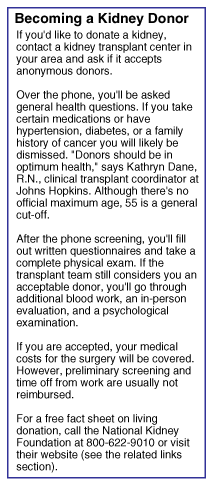Donating a kidney becomes an easier process
By Karen Asp
Everyone has a different calling in life. Sometimes it's extraordinary, as it was for Indiana resident Joyce Roush. In September 1999, Roush made medical history by being one of the first people to donate a kidney to an unknown recipient -- anyone who could use it. "Each of us has a gift to share with the world," she says, "and this was mine."
Roush, who works for an organization that coordinates organ donation, made her decision after learning about a new surgery for kidney donation that is less painful and requires less recovery time for donors. Now she hopes others will be inspired to do what she did.
Why live donation?
Kidneys are in short supply. As of May 2000, more than 45,000 Americans were on the waiting list for a kidney, according to the National Kidney Foundation (NKF). In 1999, more than 2,000 people died waiting for a kidney.
While kidneys can be transplanted from people who have died, they can also be transplanted from living donors. The latter option is more advantageous, says Lloyd Ratner, M.D., director of renal transplantation at Johns Hopkins Hospital, in Baltimore, Maryland.
Living donation increases the odds that the kidney will function properly. The long- and short-term recovery rates are also better. While kidneys from cadavers have a 50-50 chance of functioning nine or more years, kidneys from living donors stand a 50-50 chance of functioning 15 or more years.
To persuade more people to become living donors, Dr. Ratner and colleague Lou Kavoussi, M.D., pioneered a technique called laparoscopic live-donor nephrectomy, in which the kidney is removed through an incision less than 2 inches long. The result? An easier, less painful procedure for donors.

Simplifying transplantation for donors
Before the development of this laparoscopic surgery, people who wanted to donate a kidney had to commit not only their body but also a good deal of their time. Hospital stays lasted an average of six days, after which donors would spend the next several months recovering. Recovery was often painful, and donors would be left with a scar from the 7- to 8-inch incision.
For many, especially those who couldn't afford to take time off from work, the drawbacks were too great. "We wanted to remove all of the disincentives about kidney donation," Dr. Ratner says.
With laparoscopic surgery, which takes about three hours and requires only four small incisions, donors typically return home from the hospital two or three days after the operation. Some even return the next day.
Recovery time is also significantly shorter. Donors can resume their normal routine, with the exception of performing strenuous activities like heavy lifting, as soon as they feel up to it. Some donors, like Roush, return to work two weeks after surgery.
Preparation for the surgery is also simple. Donors are asked not to eat or drink anything eight hours before the surgery. Also, women on birth control pills are asked to stop taking their medication four to six weeks before surgery, unless they're taking the pills for medical reasons.
After the surgery, donors don't have to make any changes in their lives. They're advised against participating in aggressive contact sports, like football, but overall they lead completely normal lives.
Currently, of the 244 kidney transplant programs in the United States, doctors at nearly 100 of them are now performing or learning the laparoscopic live-donor nephrectomy.
Since the surgery was introduced in 1995, the number of living donor transplants performed at Johns Hopkins has tripled. Other hospitals also report a significant increase in living donor transplants. Of the 12,517 kidney transplants performed across the country in 1999, 4,153 were from living donors, a significant increase from previous years, says the NKF.
That's good news for people like Christopher "Bear" Bieniek, a 13-year-old from Maryland who once spent eight hours a day hooked up to a kidney dialysis machine. Thanks to Roush, he now has a new shot at life.
Bieniek's family has called Roush their angel. But Roush, who says the surgery and recovery went smoothly, believes she's neither angel nor hero. She adds, "I'm just a normal person who had the opportunity to do something special for somebody else."
Related link:
Outside link: Information on kidney donation and transplants from the National Kidney Foundation

